Sri Lanka History, Language and Culture
History of Sri Lanka
Sri Lanka's documented history begins around the 6th century BCE with the arrival of the Sinhalese people from northern India. According to tradition, Prince Vijaya led these early settlers, establishing the foundations of Sinhalese culture. Buddhism was introduced in the 3rd century BCE by Mahinda, the son of Indian Emperor Ashoka, profoundly influencing the island's culture and architecture. This period saw the rise of ancient cities like Anuradhapura and Polonnaruwa, renowned for their sophisticated irrigation systems and monumental stupas.
Sri Lanka's strategic maritime position attracted European colonial powers. The Portuguese arrived in the early 16th century, establishing control over coastal areas. They were succeeded by the Dutch in the 17th century, who expanded colonial rule. In 1815, the British took control, unifying the island under a single administration for the first time. During British rule, the island, then known as Ceylon, saw significant changes, including the introduction of plantation agriculture—tea, rubber, and coffee—and the development of infrastructure like railways and roads.
The early 20th century marked a surge in nationalist movements advocating for self-governance. Ceylon gained independence from British colonial rule on February 4, 1948. In 1972, the nation adopted a republican constitution, changing its name to Sri Lanka. Post-independence, the country faced ethnic tensions between the Sinhalese majority and the Tamil minority, culminating in a prolonged civil war from 1983 to 2009. The end of the conflict ushered in a period of reconstruction and reconciliation. In recent years, Sri Lanka has focused on economic development and political reforms, striving to heal from past conflicts and build a prosperous future.
Today, Sri Lanka stands as a testament to resilience, offering a unique blend of historical sites, cultural diversity, and natural beauty, inviting visitors to explore its storied past and vibrant present.
Did you know?
• Sri Lanka had a sophisticated ancient irrigation system known as the tank cascade system, which was developed over 2,000 years ago.
• In Sri Lankan culture, a distinctive side-to-side head wobble is commonly used to indicate agreement or acknowledgement.
• In many Sri Lankan towns, you might hear the tune of Beethoven's "Für Elise" playing from tuk-tuks. These are mobile bakeries selling fresh bread and pastries.
Sri Lanka Culture
Religion in Sri Lanka
Buddhists (70.2%), Hindus (12.6%), Muslims (9.7%), Christians (7.4%).
Social Conventions in Sri Lanka
A traditional Sri Lankan greeting, the 'Ayubowan' gesture, involves placing palms together and bowing slightly. This is commonly used when meeting someone for the first time. A handshake is standard in business settings, though some may prefer a nod or the traditional greeting instead.
The right hand is traditionally used for giving, receiving, and eating, as the left hand is considered unclean. When handling money or offering something, it is polite to use the right hand or both hands together.
Casual attire is acceptable in most places, but modest dress is required at religious sites. Visitors should cover their shoulders and knees when entering temples, shrines, and other sacred places. Shoes and hats must be removed before entering. Additionally, turning your back to a Buddha statue while taking photos is considered disrespectful, and pointing at religious figures or touching sacred objects should be avoided.
Public displays of affection are not widely accepted in Sri Lanka. Holding hands is generally fine, but kissing and other forms of physical affection in public are frowned upon.
Bargaining is expected in markets and with tuk-tuk drivers, but should always be done politely. In restaurants, a 10% tip is appreciated, even when a service charge is included.
Finally, expect a lot of head waggling—a signature Sri Lankan gesture that can mean yes, no, or maybe, depending on the context.
Language in Sri Lanka
Sri Lanka has two official languages: Sinhala (spoken by the majority of the population), and Tamil (primarily spoken in the Northern and Eastern provinces).
English is widely used as a link language, especially in business, tourism, and government affairs.



